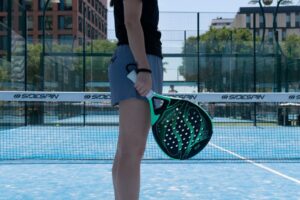Essential Padel Terms Every Beginner Should Know
2 min read
Essential Padel Terms Every Beginner Should Know
If you’re new to the world of padel, it’s important to familiarize yourself with some of the key terms and jargon used in the sport. From the rules of the game to the various techniques and strategies, understanding these essential padel terms will help you enjoy and excel in this exciting and rapidly growing sport.
The Court
The padel court is smaller than a tennis court, measuring 20m x 10m. It is surrounded by walls on all sides, and there is a net in the middle that separates each team. The service line is located halfway between the net and the back wall, and there is also a service box on each side of the court where the ball must land when serving.
The Equipment
Padel rackets are smaller and lighter than tennis rackets, usually weighing between 350g and 400g. Padel balls are also different from tennis balls, as they are slightly smaller and have less pressure, making them easier to control and manipulate.
The Scoring System
The scoring system in padel is the same as tennis, with the first player or team to win six games by a margin of at least two games winning the set. If the match is tied at five games apiece, a tiebreaker must be played to determine the winner of the set.
The Shots
– Serve: The initial shot that starts each point, which must be hit underarm and must bounce in the service box on the opposite side of the court.
– Volley: A shot that is hit before the ball bounces on the ground, typically performed at net level.
– Smash: A powerful overhead shot that is hit downward with force, usually performed to finish a point.
– Lob: A defensive shot that is hit upward with little force, intended to send the ball high over the opponent’s head.
– Drop shot: A shot that is hit softly and with little force, intended to land just over the net and close to the opponent.
The Strategies
– Serve and Volley: A popular strategy in which the server rushes to the net to hit a volley after serving, putting pressure on the receiving team.
– Lobbing: A strategy that involves hitting high, defensive lobs to force the opponent back and create more space on the court.
– Poaching: A tactic in which one player at the net moves quickly to intercept a shot that was intended for their partner, allowing them to surprise the opponent and win the point.
Conclusion
By familiarizing yourself with these essential padel terms, you’ll be well on your way to mastering this fun and exciting sport. Of course, like any new activity, it takes time and practice to improve your skills, but with a solid understanding of the rules, equipment, shots, and strategies, you’ll be on your way to becoming a successful padel player in no time.







